
At the National Veterinary School of Alfort, animal testing is a laughing matter
In a video published in 2021 in an article by EnvA, we hear the staff laughing heartily while one of these horses is in the middle of experimental surgery.
To test surgical veterinary techniques, the National Veterinary School of Alfort [l’École nationale vétérinaire d’Alfort (EnvA)] uses ‘experimental’ mares and horses who will never know anything other than animal testing. In a video published in 2021 in an article by EnvA, we hear the staff laughing heartily while one of these horses is in the middle of experimental surgery.
Image: Screenshot of the S1 video from the paper “Balloon catheter occlusion of the maxillary, internal, and external carotid arteries in standing horses”
Following the publication of certain malicious messages on social networks against the veterinary school, the staff, students in fact, asked us to show moderation and to remain intrinsically non-violent, as we always have done. Insults, threats, and injuries never help the animals or the fights that we are leading together. Thanks to you.
The use of animal testing in veterinary research is a complex subject: is it acceptable to use animals to develop medications and surgical procedures for other animals? The question is raised with this study by EnvA, published in February 2021,which tests the feasibility of the occlusion of various arteries in standing horses and mares, with the idea of having a less risky solution to general anaesthesia to treat horses and mares affected by guttural pouch mycosis, a serious illness.
From experimental surgery to the anatomy table
This same question comes up much less when we know that the animals used for the first phase of the study were not presenting with any illness – while the second phase of the study tested the procedure on mares and horses that were unwell, with the agreement of their ‘owners’, with the aim of curing them.
Therefore, it was four ‘experimental’ mares and four ‘experimental’ horses in good health who had not asked for any of this but who had had the misfortune of having been bred for it. For the study that we are talking about, these individuals were subjected to invasive surgical acts on two occasions, in the neck, face, or gum areas.
After being used for these experimental surgeries, all of the animals were killed to be used for use in education of the equine anatomy. Anyone would think that alternative methods for specialised training (such as simulators or augmented reality apps) have still not been successful in becoming established in France.
Warning: the images are difficult to look at.
Animal testing is a laughing matter
Evidently, surgical operations do not always go as planned – something which is also true for experimental surgeries. ‘Horse 4’ was thus calmly subjected to the first surgery but showed signs of anxiety and an increase in its respiration during the second surgery, even moving around uncontrollably despite the sedative.
The article provides a video extract of this moment of the surgery. Warning: the footage is difficult to watch. Evidently, it is difficult to watch because it involves surgery. But it is even more difficult to watch when we know that this horse was perfectly well before being made to submit to this intervention and that it was killed a few days later. Above all, the end of the video (after the occlusion of the artery is released and the surgeon has left the camera’s field), where we hear the staff laughing, is utterly obscene.
As if the expressions of anxiety and neurological disorders of this individual could make you laugh. Truly, animal testing feeds a very particular conception of animals.
Translated from the French by Joely Justice